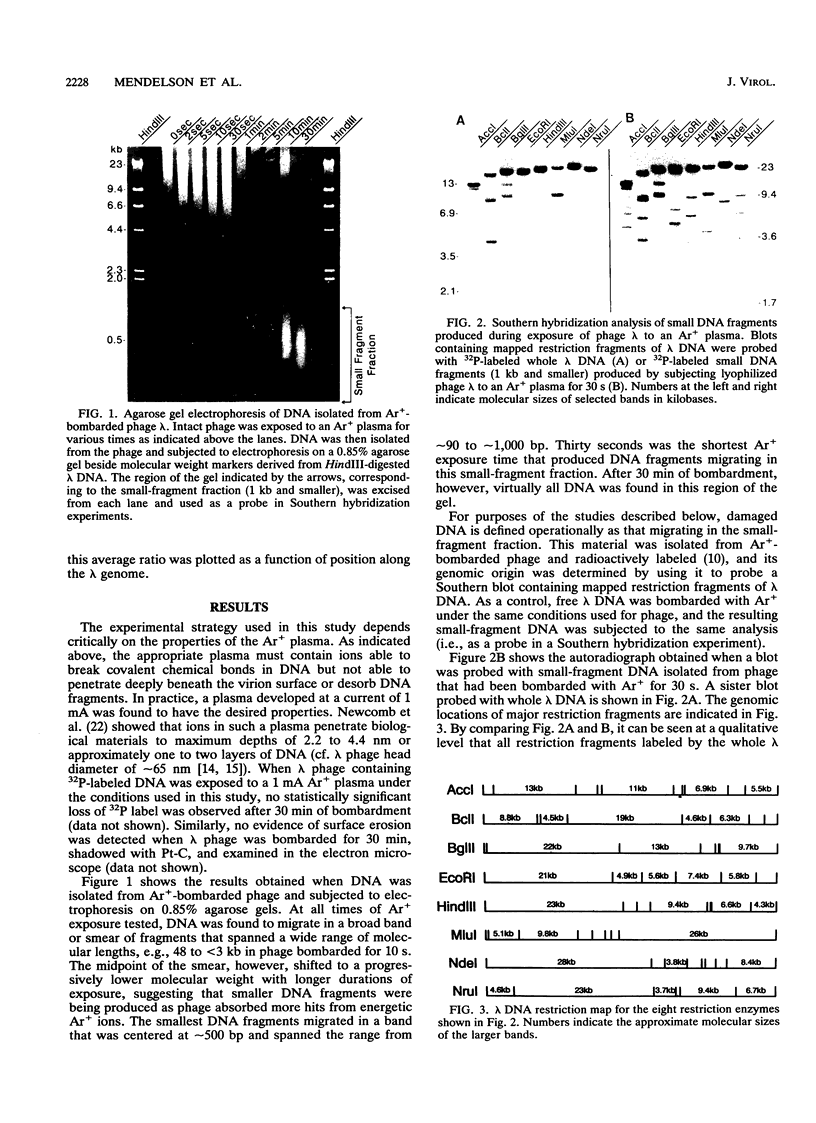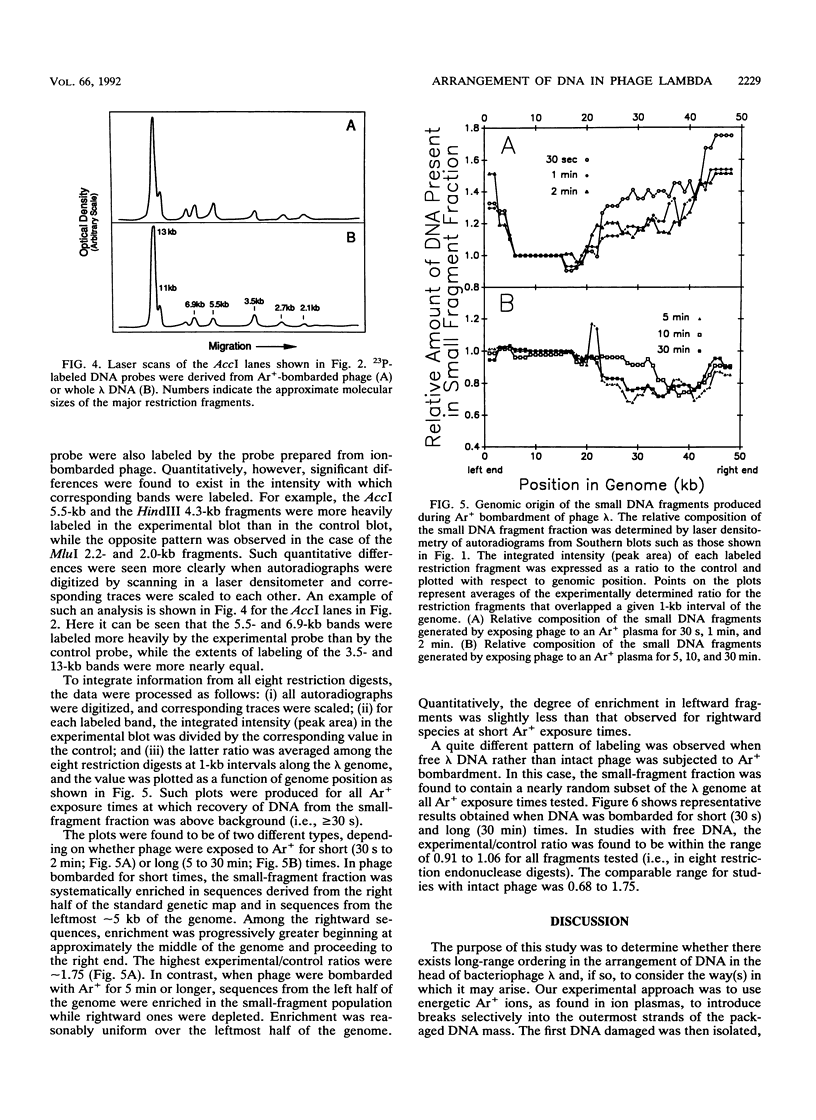Abstract
Bacteriophage lambda was bombarded with low-energy Ar+ ions with the goal of determining whether particular regions of the DNA genome are found preferentially in the outer portion of the packaged DNA mass. The strategy was to fragment the DNA selectively near the surface of the virus by exposing intact phage to Ar+ ions energetic enough to break covalent chemical bonds in DNA but not energetic enough to penetrate deeply beneath the viral capsid shell. Broken DNA was then isolated, and its genomic origin was identified by Southern hybridization to mapped restriction fragments of lambda DNA. Analysis of such Southern blots revealed that all regions of the lambda genome were represented among the small DNA fragments generated during all times of Ar+ bombardment examined. Depending on the duration of exposure, however, particular regions of the genome were found to be enriched in the small-fragment population. After short periods of exposure, sequences from the leftmost 10% and from the right half of the standard genetic map were enriched in the broken-DNA fraction. Among sequences in the right half of the genome, the enrichment was progressively more pronounced beginning in the middle of the genetic map and proceeding toward the right end. In phage bombarded for longer periods of time, rightward sequences were preferentially depleted in the small-fragment population. In contrast, when Ar+ bombardment was carried out with free lambda DNA rather than intact phage, small DNA fragments arose uniformly from all regions of the genome at all times of exposure examined. The results indicate that in the intact phage, DNA sequences from the right half and from the very leftmost regions of the genome have a tendency to lie closer to the capsid than does the remainder of the genome. Since DNA is packaged into the prohead beginning at the left end, our results suggest that packaging occurs in such a way that newly entering DNA tends to be disposed externally to that packaged at earlier times.
Full text
PDF





Images in this article
Selected References
These references are in PubMed. This may not be the complete list of references from this article.
- Black L. W. DNA packaging in dsDNA bacteriophages. Annu Rev Microbiol. 1989;43:267–292. doi: 10.1146/annurev.mi.43.100189.001411. [DOI] [PubMed] [Google Scholar]
- Black L. W., Newcomb W. W., Boring J. W., Brown J. C. Ion etching bacteriophage T4: support for a spiral-fold model of packaged DNA. Proc Natl Acad Sci U S A. 1985 Dec;82(23):7960–7964. doi: 10.1073/pnas.82.23.7960. [DOI] [PMC free article] [PubMed] [Google Scholar]
- Black L. W., Silverman D. J. Model for DNA packaging into bacteriophage T4 heads. J Virol. 1978 Nov;28(2):643–655. doi: 10.1128/jvi.28.2.643-655.1978. [DOI] [PMC free article] [PubMed] [Google Scholar]
- Brown J. C., Newcomb W. W. Ion etching of bacteriophage lambda: evidence that the right end of the DNA is located at the outside of the phage DNA mass. J Virol. 1986 Nov;60(2):564–568. doi: 10.1128/jvi.60.2.564-568.1986. [DOI] [PMC free article] [PubMed] [Google Scholar]
- Earnshaw W. C., Casjens S. R. DNA packaging by the double-stranded DNA bacteriophages. Cell. 1980 Sep;21(2):319–331. doi: 10.1016/0092-8674(80)90468-7. [DOI] [PubMed] [Google Scholar]
- Earnshaw W. C., Harrison S. C. DNA arrangement in isometric phage heads. Nature. 1977 Aug 18;268(5621):598–602. doi: 10.1038/268598a0. [DOI] [PubMed] [Google Scholar]
- Earnshaw W. C., King J., Harrison S. C., Eiserling F. A. The structural organization of DNA packaged within the heads of T4 wild-type, isometric and giant bacteriophages. Cell. 1978 Jul;14(3):559–568. doi: 10.1016/0092-8674(78)90242-8. [DOI] [PubMed] [Google Scholar]
- Emmons S. W. Bacteriophage lambda derivatives carrying two copies of the cohesive end site. J Mol Biol. 1974 Mar 15;83(4):511–525. doi: 10.1016/0022-2836(74)90511-7. [DOI] [PubMed] [Google Scholar]
- Feinberg A. P., Vogelstein B. A technique for radiolabeling DNA restriction endonuclease fragments to high specific activity. Anal Biochem. 1983 Jul 1;132(1):6–13. doi: 10.1016/0003-2697(83)90418-9. [DOI] [PubMed] [Google Scholar]
- Feiss M., Bublitz A. Polarized packaging of bacteriophage lambda chromosomes. J Mol Biol. 1975 Jun 5;94(4):583–594. doi: 10.1016/0022-2836(75)90323-x. [DOI] [PubMed] [Google Scholar]
- Giannoni G., Padden F. J., Jr, Keith H. D. Crystallization of DNA from dilute solution. Proc Natl Acad Sci U S A. 1969 Mar;62(3):964–971. doi: 10.1073/pnas.62.3.964. [DOI] [PMC free article] [PubMed] [Google Scholar]
- Haas R., Murphy R. F., Cantor C. R. Testing models of the arrangement of DNA inside bacteriophage lambda by crosslinking the packaged DNA. J Mol Biol. 1982 Jul 25;159(1):71–92. doi: 10.1016/0022-2836(82)90032-8. [DOI] [PubMed] [Google Scholar]
- Kemp C. L., Howatson A. F., Siminovitch L. Electron microscopy studies of mutants of lambada bacteriophage. I. General description and quantitation of viral products. Virology. 1968 Nov;36(3):490–502. doi: 10.1016/0042-6822(68)90174-8. [DOI] [PubMed] [Google Scholar]
- Lepault J., Dubochet J., Baschong W., Kellenberger E. Organization of double-stranded DNA in bacteriophages: a study by cryo-electron microscopy of vitrified samples. EMBO J. 1987 May;6(5):1507–1512. doi: 10.1002/j.1460-2075.1987.tb02393.x. [DOI] [PMC free article] [PubMed] [Google Scholar]
- Lerman L. S., Wilkerson L. S., Venable J. H., Jr, Robinson B. H. DNA packing in single crystals inferred from freeze-fracture-etch replicas. J Mol Biol. 1976 Dec;108(2):271–293. doi: 10.1016/s0022-2836(76)80121-0. [DOI] [PubMed] [Google Scholar]
- Liu L. F., Davis J. L., Calendar R. Novel topologically knotted DNA from bacteriophage P4 capsids: studies with DNA topoisomerases. Nucleic Acids Res. 1981 Aug 25;9(16):3979–3989. doi: 10.1093/nar/9.16.3979. [DOI] [PMC free article] [PubMed] [Google Scholar]
- Liu L. F., Perkocha L., Calendar R., Wang J. C. Knotted DNA from bacteriophage capsids. Proc Natl Acad Sci U S A. 1981 Sep;78(9):5498–5502. doi: 10.1073/pnas.78.9.5498. [DOI] [PMC free article] [PubMed] [Google Scholar]
- Murialdo H. Bacteriophage lambda DNA maturation and packaging. Annu Rev Biochem. 1991;60:125–153. doi: 10.1146/annurev.bi.60.070191.001013. [DOI] [PubMed] [Google Scholar]
- Murialdo H., Becker A. Head morphogenesis of complex double-stranded deoxyribonucleic acid bacteriophages. Microbiol Rev. 1978 Sep;42(3):529–576. doi: 10.1128/mr.42.3.529-576.1978. [DOI] [PMC free article] [PubMed] [Google Scholar]
- Serwer P. Arrangement of double-stranded DNA packaged in bacteriophage capsids. An alternative model. J Mol Biol. 1986 Aug 5;190(3):509–512. doi: 10.1016/0022-2836(86)90019-7. [DOI] [PubMed] [Google Scholar]
- Sternberg N., Weisberg R. Packaging of prophage and host DNA by coliphage lambda. Nature. 1975 Jul 10;256(5513):97–103. doi: 10.1038/256097a0. [DOI] [PubMed] [Google Scholar]
- Syvanen M. Processing of bacteriophage lambda DNA during its assembly into heads. J Mol Biol. 1975 Jan 15;91(2):165–174. doi: 10.1016/0022-2836(75)90157-6. [DOI] [PubMed] [Google Scholar]
- Widom J., Baldwin R. L. Tests of spool models for DNA packaging in phage lambda. J Mol Biol. 1983 Dec 25;171(4):419–437. doi: 10.1016/0022-2836(83)90038-4. [DOI] [PubMed] [Google Scholar]
- Wolfson J. S., McHugh G. L., Hooper D. C., Swartz M. N. Knotting of DNA molecules isolated from deletion mutants of intact bacteriophage P4. Nucleic Acids Res. 1985 Sep 25;13(18):6695–6702. doi: 10.1093/nar/13.18.6695. [DOI] [PMC free article] [PubMed] [Google Scholar]




